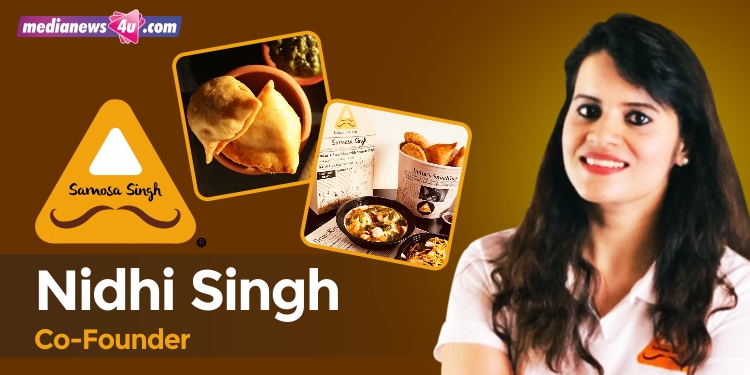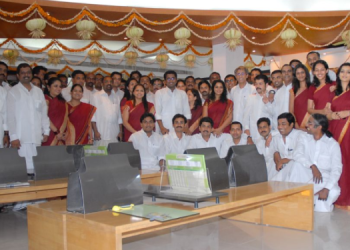How challenging was the journey to entrepreneurship for you and your co-founder at WoknStove Foodworks (and life partner, Shikhar)?
As first-time entrepreneurs, obviously nothing comes easy. We had our own set of challenges. We had to understand the food business. We learnt along the way. We did our mistakes but we continued to grow. We were very clear with our vision from the beginning, from day one. In terms of what we want to do and how we want to do it, there were no doubts.
Covid happened and made our business zero. But we started again from scratch and continued to build it. It was tough, but as we always say, science is actually involved in everything. Though we never had an entrepreneurial background, we understood the science behind food. We applied the same at Samosa Singh. We did a lot of R&D and that’s why we were able to actually come up stronger during the most challenging Covid phases.
Samosa Singh was founded in 2016. How has been the growth year-on-year?
We incorporated our company in 2016. We started our operations one year later after doing significant R&D. We were very clear that if we launch any brand around samosa, it has to be consistent across locations. Samosa is a volume product. It can’t be that you have one experience in one location and when you scale to another city your experience changes. That is why we had to have central manufacturing.
When we started in 2017, we started mainly as a B2B player. We used to make these samosas in a central manufacturing facility in Bengaluru and supply to all these big marquee clients across corporate, aviation and multiplexes – Inox, Cinepolis, PVR; HP, HCL, Bosch, Amazon, Big Basket and Cafe Coffee Day; and in aviation AirAsia. The business was growing really well and we were a profitable company.
Then we decided to slowly cater to B2C and have our own brand, Samosa Singh. In January 2020, we opened our first flagship store at Bangalore International Airport. We opened it in mid-January and by mid-February we started seeing some Covid-related news and new rules and other limitations at the airport. In March, our entire B2B business shut; the multiplexes and corporates were shut, airlines were shut, airports were closed. Ninety nine percent of the business which was coming from all these closed overnight. Obviously, it was a very challenging time. We didn’t know what to expect or how long it would last. But yes, it was like a rebirth.
In 2020, when our business had gone to zero, we continued doing everything in-house. We immediately pivoted. We started cloud kitchens and online deliveries. We were just in one city at that point in time, Bengaluru. But we saw that there were people who were actually looking and wanting to have samosas and chaats and other items at home. So we continued our expansion as soon as there were lockdown relaxations. All the expansion that we have done beyond Bengaluru, which is in eight cities and over 50 locations, we have done it all throughout Covid. So yes, at first the lockdown was very tough, it offered great learning and understanding. But thanks to our core strength which is our central facility manufacturing, we were able to form a very good business from zero, and then again go to multiple cities with multiple outlets.
What makes Samosa Singh different from a local samosa seller?
Samosa still stays the same. Samosa is one product which people love and they have it and they don’t really need a plan for it. I mean, every celebration, every occasion accounts for celebration with samosas. So it has always been a core part of our, I would say culture, Indian culture with samosas and street foods.
What differentiates us is we are an organised player. When people order from Samosa Singh they can expect good quality. They know that it is done freshly and they know that it is actually made in a very hygienic manner following all protocols. Plus, we are also one of the largest manufacturers and suppliers of samosas. So it’s not that we can’t handle volume. There have been cases where people actually wanted thousands and thousands of samosas in a day. Unlike any other player, we are able to do that much quickly and to a consistent quality. I think what differentiates us from any other regular samosa seller is our quality, our consistency, done in a hygienic manner. And we are able to scale it up pan India much quicker.
And obviously, I would love to say that our taste is also great. Our samosas stay crispy and they are done in an automated manner with less human intervention. You will see that our samosas that we sell in the airlines and multiplexes are a little different in shape. It actually tastes like the regular samosa. But it is different, in order to hold more moist fillings. There are fillings like kadai paneer, cheese and corn which actually are a little gooey in nature. And that shape is able to retain that filling. Plus, the filling to dough ratio is highly balanced and synchronised in this particular shape. There’s no manual intervention and the samosas stay crispy for a very long period of time. So even if you get the samosas in the afternoon and you want to have it by evening, it will still stay crispy.
Which is the largest market for the brand by city? What is the contribution of other cities?
Currently we are in two major cities which are Bengaluru and Hyderabad. These are our biggest markets. We have recently ventured into Mumbai and Pune. Mumbai has also started to pick up. So I think it’s going to be our next big city. There are smaller cities we have launched into, one of them being Vijaywada which is doing phenomenally well for us. We just have two outlets there, but they are doing really good. People are resonating with our samosas and they like the experience that they’re getting. So far so good, even in the smaller cities.
With 50-plus outlets across the country, do you have plans of further retail expansion? Also, are you planning to expand to more cities?
We are going to have a mix of bigger cities as well as tier two and tier three cities. For a product like samosa, you really have to be present not just in bigger cities but also the smaller tier two towns. And that is why we tested out in Vijayawada and Vizag and it really did well for us. The plan is that we continue our online expansion as well as our physical stores. We are now going to be expanding very soon with a few more stores in Hyderabad and also planning to scale it up pan India, including Delhi and North in the next 18 months.
Samosa Singh reportedly had an annual turnover of 45 cr. What is your target for the coming years?
That number is incorrect. All I can say is that we are profitable in all the cities. We hit a very major roadblock when Covid happened. Then we continued to scale up. Now as a company, we plan to actually scale in a much more profitable manner, get our expansion beyond India which is even into the global market through exports, which we are planning to do very soon.
Our future plans are to grow the company profitably, sustainably, beyond just India, to take it to the global market which includes the Middle East, US and Australia and everywhere. We already have the plans and it’s just going to be executed soon.
You had entered into a partnership with a D2C giant to export your products. Can you elaborate on that and have you started exporting?
This is just in the nascent stage. When the time is right, we’ll be able to share more details. While you enter into exports there are a lot of stringent protocols that countries follow. As a company, we’ve been able to get all the certifications required and we have the qualification required to enter. It’s not easy to actually get there, but we are taking baby steps one at a time, doing all the things one by one and keeping our fingers crossed. We are on the path to make it happen soon.
You have different varieties of samosas like aloo masala samosa, manchurian samosa, cheese chilli, cheese corn, butter chicken, kadai paneer samosa etc. Which is the most popular among all?
Depends on city to city. Obviously in terms of volume, what goes maximum is definitely the aloo samosa because that’s one thing which people love. And I think that’s a very native and innate of samosa.In terms of volumes, it is our highest.
In terms of our popularity, there are many, like in Hyderabad, it’s a veggie spice samosa which is more on a spicy side and a chilli cheese samosa. In Mumbai, the cheese and corn samosa goes well. There’s also another chaat variant that people like which is a dahi bhalla or a dahi samosa chaat because I think Mumbai weather calls for more dahi-based chaats.
In Bengaluru, it’s actually a good mix. Now it’s raining, so you’ll see a lot more spicy and gooey flavours like kadai paneer and then sometimes it’s more like hot chaats that go well. So it depends on city to city, season to season. But yes, some of the perennial varieties that go really well are actually our aloo masala as well as cheese and corn and the kadai paneer samosa.
Any plans to add more samosa options to the product portfolio?
We just launched in Chennai. In Chennai the Chetinadu flavor is very popular. So we are launching a seasonal variant just for that city in a Chetinadu aloo flavor.
Now in mango season, there could be a launch which is around sweet and tangy mangoes. So we keep doing those seasonal variations. But in terms of our menu, it’s more or less sorted and loved by all.
Samosa Singh has now shifted beyond samosas and you can now also find kachoris and matar kulcha…
See when people think of Samosa Singh it’s more like a small halwai (sweet) shop that sells samosas. So whatever you get in our menu is very much resonating with the menu profile that would generally be in any halwai shop. So yes, we have different varieties of samosas and we also have the basic varieties of kachori. Then obviously if you have samosas and all these things you need to have chaats because some people just don’t like to have samosa as it is. They would want to have it mashed with some chutney and dahi. They would want to have sometimes with onions or with chole. The chaats kind of come organically into it.
Then we also have small mini meals like samosa pav. Again something that resonates. We have basic sweets like moong dal halwa, rabri and gulab jamun. We are going to be launching rasmalai very soon. And then the basic beverages which are chai, jal jeera and shikanji, etc. that go well with the samosa.
Our menu is for a family that wants to choose a place that they know has flavours or varieties for everybody, but is highly focused around Indian street food and samosas.
How many units do you sell and how is it growing in unit terms?
We started very small, very humble. We started with just a few hundred samosas a day. Currently we are close to 20,000 samosas a day. it includes a lot of other variants as well.
We are treading slowly and strongly to make sure that we do all the right things. Because for a product as simple as samosas you don’t always get multiple chances to show your capability. That is why we’re taking one step at a time. But yes, the future looks bright.
How much does each product line contribute? How do you see the portfolio share going forward?
Currently our portfolio share and the product line is very much in sync with what we would want it to be with more than 70 pc of our revenue coming from samosas and samosa-based chaats. Thirty percent comes from beverages and other items. Whenever someone orders they just don’t order samosa. They generally order a samosa chaat along with different varieties of samosa or a chai along with it.
We started with a very small average order value of about Rs.100. Currently online we are doing an average order value of more than Rs.350. There are certain cities where we are doing more like Rs.400 and in certain cities where we have just launched the value is under Rs.300.
We are very happy to actually take it to that level because that is one major challenge. When you start, people just want to try with one samosa or one variety and then slowly when their faith in the brand goes up they add multiple items to the cart. So thankfully, in a few years we have been able to get there.
How has the brand been promoted so far? What are the marketing and media plans?
We haven’t done much. Whatever marketing we have done is mainly word of mouth. But now, when we’ll be present in most of the cities in India, it makes sense for us to actually do marketing and advertising, which includes the FM channels or maybe some other BTL activities.
(Updated to clarify the company’s stance that its turnover reported by another publication was incorrect.)
Feedback: [email protected]

















